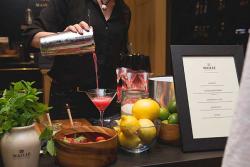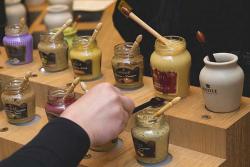Tracy finds out a lot more about how our taste buds work when she attends a Maille Mustard seminar
 Unlike Pavlov’s dogs, I might not hear bells ringing, but after a challenging day, my “paired conditioning†is to know that when I’m back home, a glass of chilled white wine will create a sense of calm and provide the antidote to any stress. While you may be inclined to link this tendency with “crutch†and “alcoholâ€Â, taste psychologist Chris Lukehurst describes it as “the association of flavours and texture with an emotional reaction†– phew!
Unlike Pavlov’s dogs, I might not hear bells ringing, but after a challenging day, my “paired conditioning†is to know that when I’m back home, a glass of chilled white wine will create a sense of calm and provide the antidote to any stress. While you may be inclined to link this tendency with “crutch†and “alcoholâ€Â, taste psychologist Chris Lukehurst describes it as “the association of flavours and texture with an emotional reaction†– phew!
At the Maille Boutique in Piccadilly, Chris spoke about the psychology of taste, explaining how our taste buds differentiate between the five tastes (sweet, salt, sour, bitter and umami) with the help of the brain that takes information from the aroma and look of the food, as well as our memories. And it is our brains, he pointed out, that drives not only our response to what we eat, but also determines our favourite – and most loathed – food and drinks.
Chris revealed that we are all born loving the taste of sweet and fat and hating anything bitter – and that any other predilection is learned, with stimuli and emotional responses ranked according to our experiences. Our mothers provide us with love, safety and comfort, and subsequently we learn to link the tastes and textures that she gives us with these feelings. Then, as we grow, the environment in which we live, other people and events all play a role in our interpretation of tastes – such as the fun of children’s parties being linked with cake and sweets.
Our environment exerts a dramatic but subconscious effect on our taste knowledge. As we age, we tend to move away from the sweet treats we loved as kids because society tells us that they are bad for us, so we learn to link sweet and fat with unpleasant associations, while we acquire the taste for bitter that we initially hated, as it’s connected to food that is considered “sophisticated†and “adultâ€Â.
 So what does these taste revelations have to do with Maille? Surrounded by about 43 varieties, it seems that my fridge staples of wholegrain and Dijon didn’t quite, um – dare I say it? – cut the mustard. I certainly would never have thought to include either in cocktails – such as the Maillegarita with a Twist, made with tequila, Cointreau, lime juice, salt and Maille mustard with dill and lime, although it went down very easily… while the La Mostarda consisted of whisky, lime juice and Maille Sauternes mustard (one of the range that is on tap in the boutique and available in refillable earthenware pots).
So what does these taste revelations have to do with Maille? Surrounded by about 43 varieties, it seems that my fridge staples of wholegrain and Dijon didn’t quite, um – dare I say it? – cut the mustard. I certainly would never have thought to include either in cocktails – such as the Maillegarita with a Twist, made with tequila, Cointreau, lime juice, salt and Maille mustard with dill and lime, although it went down very easily… while the La Mostarda consisted of whisky, lime juice and Maille Sauternes mustard (one of the range that is on tap in the boutique and available in refillable earthenware pots).
The first Maille boutique was opened by Antoine-Claude Maille in Paris in 1747 and soon became the official supplier to King Louis XV. After more than two centuries, Maison Maille maintains its sense of tradition while devising new recipes each year, using combinations of ingredients to achieve “a complex taste profile, an appealing aroma, the desired texture, and the right colourâ€Â.
Canapés by Galvin Restaurants showcased varieties such as the Honey and Modena balsamic vinegar mustard, which was drizzled over burrata served on a radicchio leaf and topped with pumpkin seeds, while whisky-marinated salmon was served with a Sauternes mustard crust on a buckwheat blini. Taking us through the mechanics of taste, Chris described how the mustard first hit the front of the mouth, making you aware of its flavour, then disappeared as it reached the middle of your mouth, allowing the other ingredients to shine. Then, when you swallowed, the flavours – which have length and depth – returned.
Mustards, such as black truffle and Chablis, add a rich bass note to cooking, bringing an earthiness to a dish, explained Chris, which transports your guests to a forest in autumn and the colours and flavours associated with it. He suggested thinking not only about flavours when cooking, but also about the emotional journey on which you wish the tastes to take your dinner guests – whether that’s to a sun-filled holiday destination, or a comforting or exhilarating space – and then tailor your food and textures to ensure this, balancing flavours so they enhance, not overpower, the ingredients.
 Whether you’re looking for a mustard to complement fish, rabbit or even a dessert, you can sample numerous options at the Maille Boutique. And if you’re struggling to remember whether it was the Chanterelles and sorrel mustard or the Hazelnut, black chanterelle mushrooms and white wine that you favoured, you’ll love the Discovery Spoon. This innovative tasting spoon has a Near Field Communication (NFC) chip, which allows you to keep track of the mustards you enjoyed by tapping the Discovery Spoon against a fixture at the base of your favourites. You will then be emailed the list, along with recipes in which the selected mustards can be used.
Whether you’re looking for a mustard to complement fish, rabbit or even a dessert, you can sample numerous options at the Maille Boutique. And if you’re struggling to remember whether it was the Chanterelles and sorrel mustard or the Hazelnut, black chanterelle mushrooms and white wine that you favoured, you’ll love the Discovery Spoon. This innovative tasting spoon has a Near Field Communication (NFC) chip, which allows you to keep track of the mustards you enjoyed by tapping the Discovery Spoon against a fixture at the base of your favourites. You will then be emailed the list, along with recipes in which the selected mustards can be used.
Their usage is extensive and certainly changed my concept of a condiment that I usually only enjoyed alongside my roast beef or in a salad dressing, but am now inspired to incorporate in dishes, such as a dollop of the Celeriac, black truffle and white wine mustard stirred into scrambled eggs. And the upside of this is that if the summer disappoints, I can take a mouthful, close my eyes, and be transported to a sun-filled “place†somewhere in Provence…
For mustards, vinegars and more, see maille.co.uk
